Gordon Grice's Blog, page 71
December 20, 2011
What Color Is This Cat?
Further to yesterday's post about oddly colored pets, Croconut provides these photos of his cat. He says it looks green to him. Others say gray-black. I confess it looks brown to me, except maybe around the neck. Anybody want to say purple?





Published on December 20, 2011 09:00
December 19, 2011
Red and White

At the swimming pool I met a family whose pets were all the wrong colors.
Steve and his brother Eli cleared land with chain saws for a living. Steve had two daughters who had no fear of strangers (or at least of me). The ten year old asked me all sorts of questions: Where do you live? Where'd you get those ugly swimming trunks? Do you like hamburgers or hot dogs better?
That last question somehow led to me getting invited to the family cookout. I rode to their place in the back of Steve's pickup with Eli's dog, a red Doberman pinscher named Gertrude. I was a little apprehensive about getting close to a strange Doberman, but I felt better when she slunk over to me and pushed her head under my hand to be petted.
I had never seen a red Dobie. She looked about like the inside of a red velvet cake. Eli said she was one of only 60 in the country. He had paid good money for her. He mentioned all the surgeries she had had because of her stomach problems. "Didn't you have surgeries?" he said in a baby voice and kissed her on the mouth.
Once we arrived at Steve's place, he brought out his own pet. I nearly dropped my hamburger. The pet was white and had demonic red eyes, and the first thing it did was run up Steve's left sleeve and come out his right.
"It's an albino ferret," Steve said, too late to prevent my stomach from jumping onto my left shoulder blade.
I never found out why both brothers had chosen pets of unusual color. When I mentioned the subject, Eli said "I don't consider Gertrude a pet. She's more like a child."
Later, Steve said, "Eli goes overboard about that dog. Doesn't he, Precious?" And he kissed the ferret.
Photo: Marshman/Creative Commons
Published on December 19, 2011 10:03
December 17, 2011
Troubled Skies

I hate the kind of calendar that shows me, for example, a snow scene in February. In February, I have seen plenty of snow, can see more of it any time I want by looking out my window, and really would prefer to see less of it. I'd like a calendar that shows the opposite of whatever I can see from my own window.
In that spirit, I offer a few spring skies. These first two shots are from shortly after dawn; the sky looked volcanic, but nothing much happened.

These next four shots were taken within four minutes in mid-morning, all from our back yard. The sky's color changed rapidly (all of these are the real colors, not manipulated). A storm rumbled in shortly.
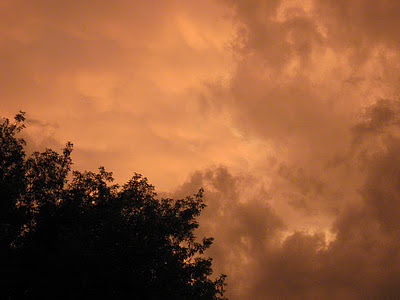



Related Post: The Day after Summer
Photography by Parker Grice
Published on December 17, 2011 09:00
December 16, 2011
Gibbon Attacks Toddler
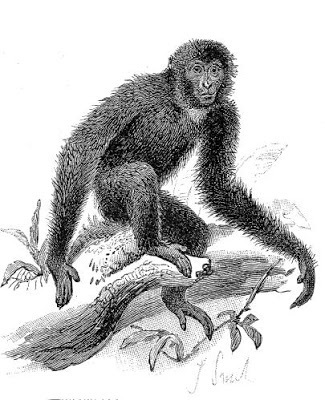
In a Malaysian zoo, a siamang has attacked and severely injured a three-year-old boy.
The siamang is the largest of the gibbons or "lesser" apes--as opposed to the better known "great" apes, including the chimpanzees, orangutans, and gorillas. This article lists the attacker at 38 kilos (84 pounds), which is probably a typo; the average for this species is under 30 pounds, though they may stand four feet tall or so as they waddle on the ground. They'd prefer to swing by their arms.
The news report (linked below) gives no information on the reason for the attack, though all primates are potentially dangerous and can become aggressive for no obvious reason.
The most startling characteristic of the siamang, aside from biting zoo visitors, is its habit of inflating its neck to the size of a pumpkin and bellowing like a game show contestant imitating a pig. This sound can be heard by gibbons in the next neighborhood.
'Tame' gibbon attacks boy at zoo - General - New Straits Times: "I was shocked and screamed. My husband, who at first did not realise what was happening, acted fast and held the gibbon's head. But it refused to let go of my son's thigh. The gibbon only let go when another visitor kicked its stomach."
Published on December 16, 2011 09:00
December 15, 2011
Escape of the Snapping Turtle
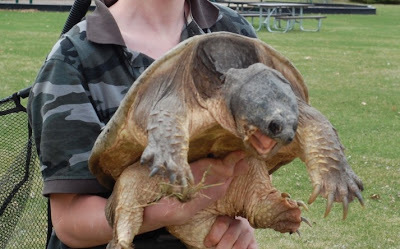
Captured by kids, this snapping turtle strives to escape.
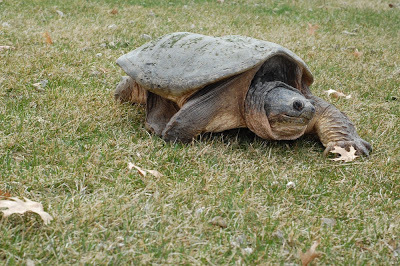
Released, it makes its break.
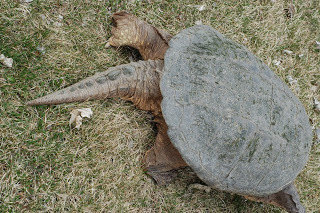
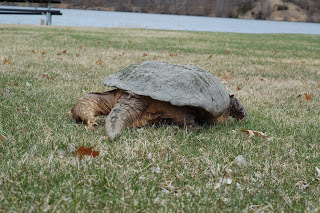
The kids follow and watch.
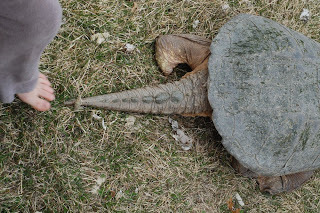


At last, with a little human help, the turtle reaches the safety of the river.
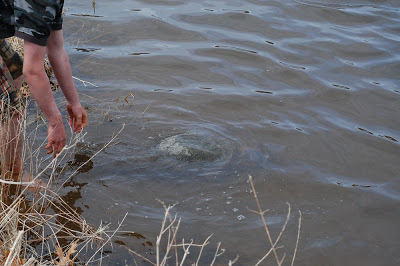 Photos by Elizabeth Murphy
Photos by Elizabeth Murphy
Published on December 15, 2011 09:10
December 14, 2011
The Times on Deadly Animals
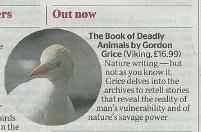
A nice mention for The Book of Deadly Animals the other day in the Times of London, which praises the book as "Nature writing--but not as you know it."
Published on December 14, 2011 09:00
December 13, 2011
Arana Capulina -- A Black Widow Spider
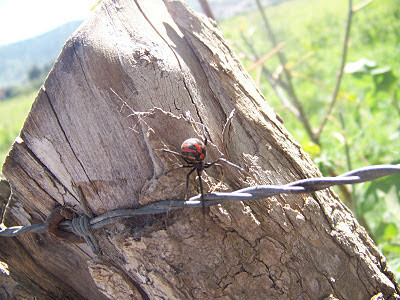
As readers of The Red Hourglass will know, the black widow spideris a special favorite of mine. Hodari Nundu recently sent me these photos of ablack widow he found building a web above his cat's litter box.
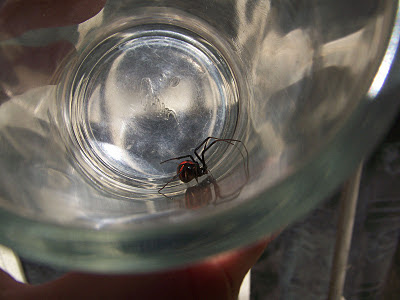
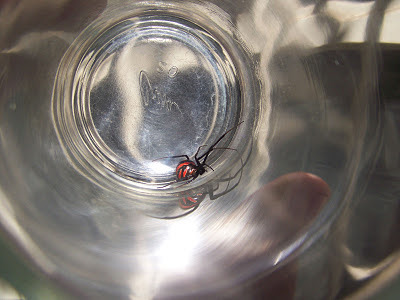

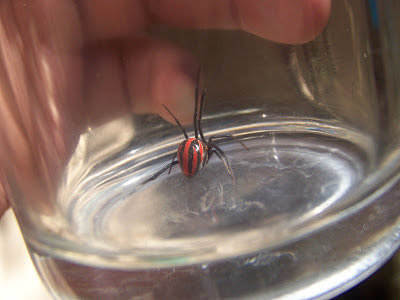
Hodari captured the spider in a jar, then released it outdoors.
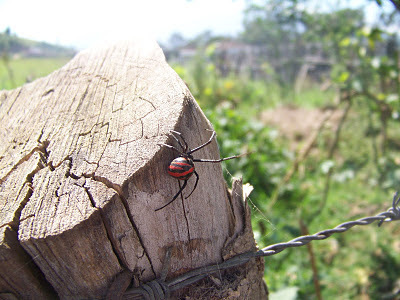
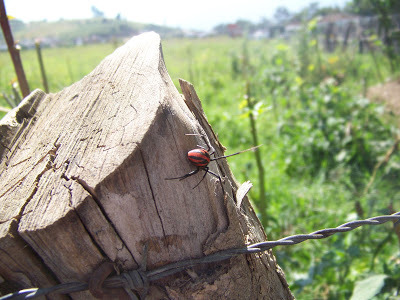
Hodari tells me that where he lives in Mexico, this spider is sometimes called viuda negra, which means black widow, and sometimes araña capulina, or black cherry spider. It's a nifty name because, aside from the outward resemblance between spider and black cherry, both are also toxic. The leaves and seeds of the black cherry contain cyanide compounds that often kill livestock.
 Rasbak/Creative Commons
Rasbak/Creative Commons
Published on December 13, 2011 09:00
Arana Capulina -- A Black Widow

As readers of The Red Hourglass will know, the black widow spideris a special favorite of mine. Hodari Nundu recently sent me these photos of ablack widow he found building a web above his cat's litter box.




Hodari captured the spider in a jar, then released it outdoors.


Hodari tells me that where he lives in Mexico, this spider is sometimes called viuda negra, which means black widow, and sometimes araña capulina, or black cherry spider. It's a nifty name because, aside from the outward resemblance between spider and black cherry, both are also toxic. The leaves and seeds of the black cherry contain cyanide compounds that often kill livestock.
 Rasbak/Creative Commons
Rasbak/Creative Commons
Published on December 13, 2011 09:00
December 12, 2011
A Warning to Intruders
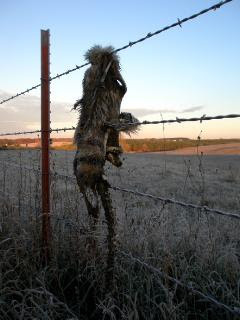
I directed my glass [i.e., telescope] to the house. There were no signs of life, but there was the ruined roof, the long mud wall peeping above the grass, with three little square window-holes, no two of the same size; all this brought within reach of my hand, as it were. And then I made a brusque movement, and one of the remaining posts of that vanished fence leaped up in the field of my glass. You remember I told you I had been struck at the distance by certain attempts at ornamentation, rather remarkable in the ruinous aspect of the place. Now I had suddenly a nearer view, and its first result was to make me throw my head back as if before a blow. Then I went carefully from post to post with my glass, and I saw my mistake. These round knobs were not ornamental but symbolic; they were expressive and puzzling, striking and disturbing—food for thought and also for the vultures if there had been any looking down from the sky; but at all events for such ants as were industrious enough to ascend the pole. They would have been even more impressive, those heads on the stakes, if their faces had not been turned to the house. Only one, the first I had made out, was facing my way. I was not so shocked as you may think. The start back I had given was really nothing but a movement of surprise. I had expected to see a knob of wood there, you know. I returned deliberately to the first I had seen—and there it was, black, dried, sunken, with closed eyelids,—a head that seemed to sleep at the top of that pole, and, with the shrunken dry lips showing a narrow white line of the teeth, was smiling too, smiling continuously at some endless and jocose dream of that eternal slumber.
Heart of Darkness
Joseph Conrad

When I was a kid, common wisdom was that you could keep coyotes out of your pasture by shooting one of them and draping its carcass over the barbed wire. Supposedly the other coyotes would take the hint. Maybe that was the thinking behind the carcass you see here. D'Arcy was out early one morning, photographing the prismatic frost that covered everything, when she noticed this dead raccoon. She was repulsed, but knew the duty of anyone with a camera and a blogging friend.

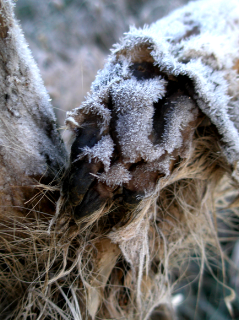

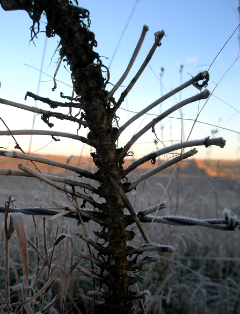
Published on December 12, 2011 09:23
December 11, 2011
Book of Deadly Animals Reviewed in Mail on Sunday

Another full-page rave for The Book of Deadly Animals, this time in Britain's Mail on Sunday.
"Though I can imagine this book making a perfect stocking-filler for adolescent boys, it's also a beautifully written, well-researched work," says reviewer James Delingpole. He gives it four stars.
Published on December 11, 2011 09:00



